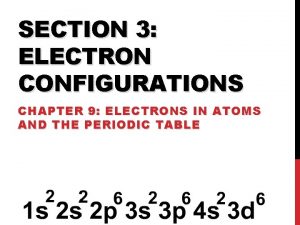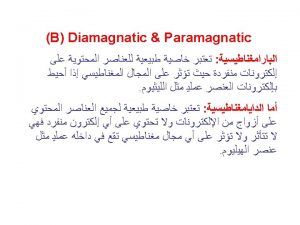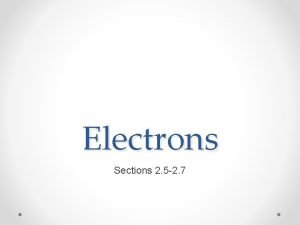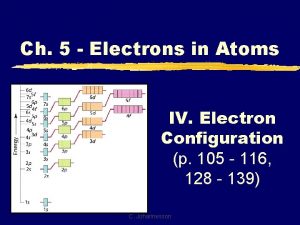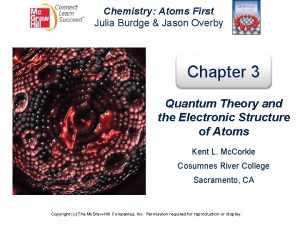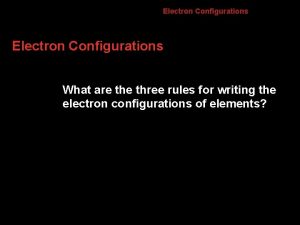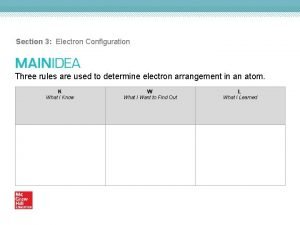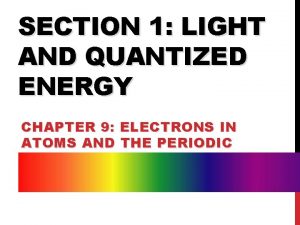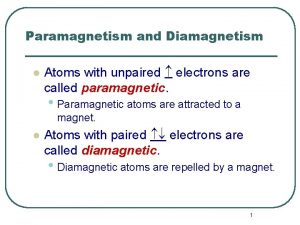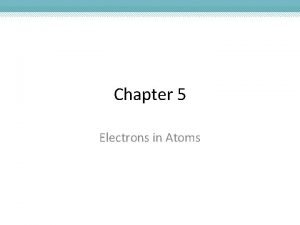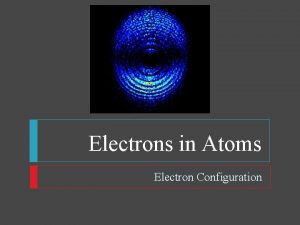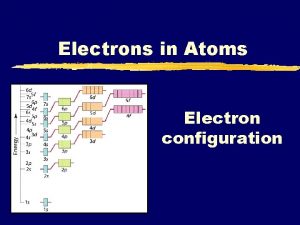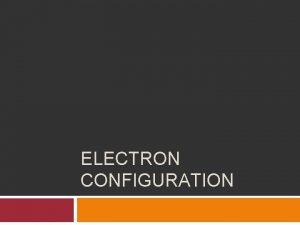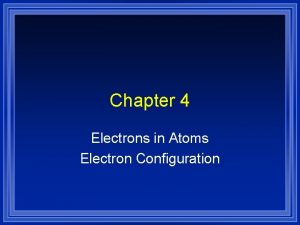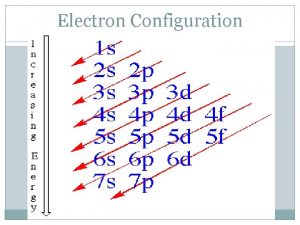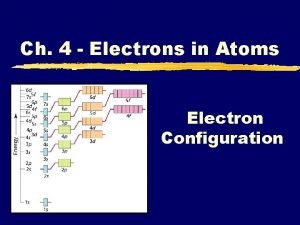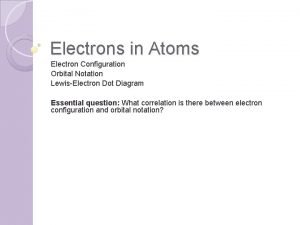Electrons in Atoms Electron Configuration General Rules Pauli










![Periodic Patterns • Example - Germanium [Ar] 2 4 s 10 3 d 2 Periodic Patterns • Example - Germanium [Ar] 2 4 s 10 3 d 2](https://slidetodoc.com/presentation_image_h2/18d4f3be03dfd31b6d55216f20ee2c8d/image-11.jpg)



![Stability • Electron Configuration Exceptions • Copper EXPECT: [Ar] 4 s 2 3 d Stability • Electron Configuration Exceptions • Copper EXPECT: [Ar] 4 s 2 3 d](https://slidetodoc.com/presentation_image_h2/18d4f3be03dfd31b6d55216f20ee2c8d/image-15.jpg)
![Stability • Electron Configuration Exceptions • Chromium EXPECT: ACTUALLY: [Ar] 4 s 2 3 Stability • Electron Configuration Exceptions • Chromium EXPECT: ACTUALLY: [Ar] 4 s 2 3](https://slidetodoc.com/presentation_image_h2/18d4f3be03dfd31b6d55216f20ee2c8d/image-16.jpg)


- Slides: 18

Electrons in Atoms Electron Configuration

General Rules • Pauli Exclusion Principle • Each orbital can hold TWO electrons with opposite spins.

General Rules • Aufbau Principle • Electrons fill the lowest energy orbitals first. • “Lazy Tenant Rule”

General Rules • Hund’s Rule • Within a sublevel, place one eper orbital before pairing them. • “Empty Bus Seat Rule” WRONG RIGHT

General Rules • There • s • p • d • f are 4 types of orbitals: can hold a maximum of 2 electrons can hold a maximum of 6 electrons can hold a maximum of 10 electrons can hold a maximum of 14 electrons

Periodic Patterns s p 1 2 3 4 5 6 7 f (n-2) d (n-1) 6 7 © 1998 by Harcourt Brace & Company

Periodic Patterns

Periodic Patterns • Period # • energy level (subtract for d & f) • Column within sublevel block • # of e- in sublevel

Periodic Patterns • Example - Hydrogen 1 1 s 1 st Period 1 st column of s-block

Notation • Orbital Diagram O 8 e- 1 s 2 s • Electron Configuration 2 2 4 1 s 2 s 2 p 2 p
![Periodic Patterns Example Germanium Ar 2 4 s 10 3 d 2 Periodic Patterns • Example - Germanium [Ar] 2 4 s 10 3 d 2](https://slidetodoc.com/presentation_image_h2/18d4f3be03dfd31b6d55216f20ee2c8d/image-11.jpg)
Periodic Patterns • Example - Germanium [Ar] 2 4 s 10 3 d 2 4 p

Notation • Longhand Configuration S 16 e 2 1 s 2 6 2 2 s 2 p 3 s 4 3 p Valence Electrons • Shorthand Configuration S 16 e 2 4 [Ne] 3 s 3 p

Practice Time • Give the longhand shorthand configurations for the following: • Al • Co • As • Sr • Sn • Pb 1 s 22 p 63 s 23 p 1 or [Ne] 3 s 23 p 1 1 s 22 p 63 s 23 p 64 s 23 d 7 or [Ar] 4 s 23 d 7 1 s 22 p 63 s 23 p 64 s 23 d 104 p 3 or [Ar] 4 s 23 d 104 p 3 1 s 22 p 63 s 23 p 64 s 23 d 104 p 65 s 2 or [Kr] 5 s 2 1 s 22 p 63 s 23 p 64 s 23 d 104 p 65 s 24 d 105 p 2 or [Kr] 5 s 24 d 105 p 2 1 s 22 p 63 s 23 p 64 s 23 d 104 p 65 s 24 d 105 p 66 s 24 f 145 d 106 p 2 or [Xe] 6 s 24 f 145 d 106 p 2

Stability • Full energy level • Full sublevel (s, p, d, f) • Half-full sublevel
![Stability Electron Configuration Exceptions Copper EXPECT Ar 4 s 2 3 d Stability • Electron Configuration Exceptions • Copper EXPECT: [Ar] 4 s 2 3 d](https://slidetodoc.com/presentation_image_h2/18d4f3be03dfd31b6d55216f20ee2c8d/image-15.jpg)
Stability • Electron Configuration Exceptions • Copper EXPECT: [Ar] 4 s 2 3 d 9 ACTUALLY: [Ar] 4 s 1 3 d 10 • Copper gains stability with a full d-sublevel.
![Stability Electron Configuration Exceptions Chromium EXPECT ACTUALLY Ar 4 s 2 3 Stability • Electron Configuration Exceptions • Chromium EXPECT: ACTUALLY: [Ar] 4 s 2 3](https://slidetodoc.com/presentation_image_h2/18d4f3be03dfd31b6d55216f20ee2c8d/image-16.jpg)
Stability • Electron Configuration Exceptions • Chromium EXPECT: ACTUALLY: [Ar] 4 s 2 3 d 4 [Ar] 4 s 1 3 d 5 • Chromium gains stability with a halffull d-sublevel.

Stability • Ion Formation • Atoms gain or lose electrons to become more stable.

Stability • Ion Electron Configuration • Write the e- config for the closest Noble Gas • EX: Oxygen ion O 2 - Ne O 2 - 10 e- [He] 2 s 2 2 p 6
 S orbital
S orbital Paulis rule
Paulis rule Paramagnetic unpaired electrons
Paramagnetic unpaired electrons 1s 22 s22 p63 s23 p64
1s 22 s22 p63 s23 p64 Electron configuration for oxygen
Electron configuration for oxygen Electron configuration vs noble gas configuration
Electron configuration vs noble gas configuration Variable in electron configuration
Variable in electron configuration Electron configuration rules
Electron configuration rules Ground state electron configuration of arsenic
Ground state electron configuration of arsenic What are the three rules for writing electron configuration
What are the three rules for writing electron configuration Three rules of electron configuration
Three rules of electron configuration Periodic table of elements regents
Periodic table of elements regents Electrons in atoms section 1 light and quantized energy
Electrons in atoms section 1 light and quantized energy Atoms with 4 valence electrons
Atoms with 4 valence electrons Diamagnetic elements
Diamagnetic elements Number of protons in hydrogen
Number of protons in hydrogen Electrons in atoms section 1 light and quantized energy
Electrons in atoms section 1 light and quantized energy What is the lowest allowable energy state of an atom
What is the lowest allowable energy state of an atom Electrons in atoms section 2 quantum theory and the atom
Electrons in atoms section 2 quantum theory and the atom
